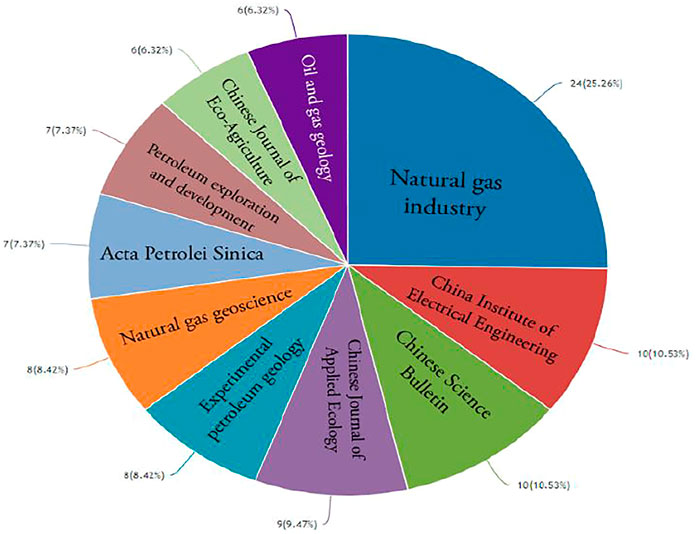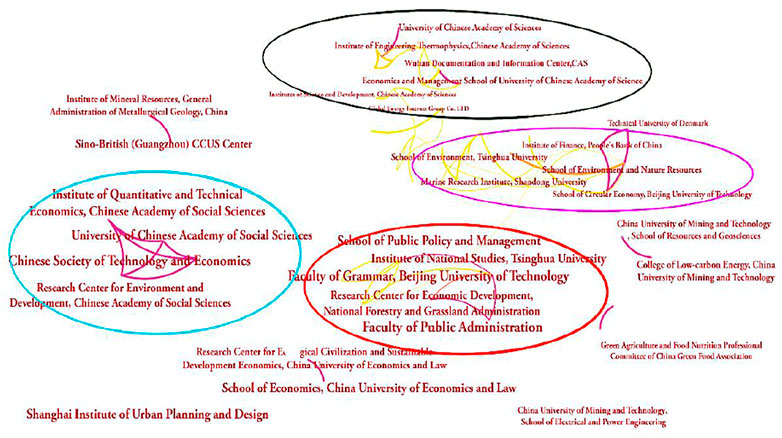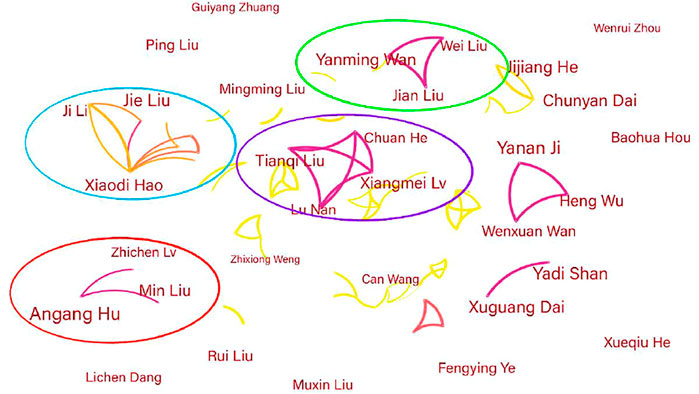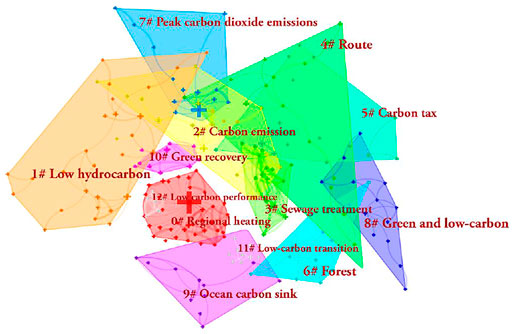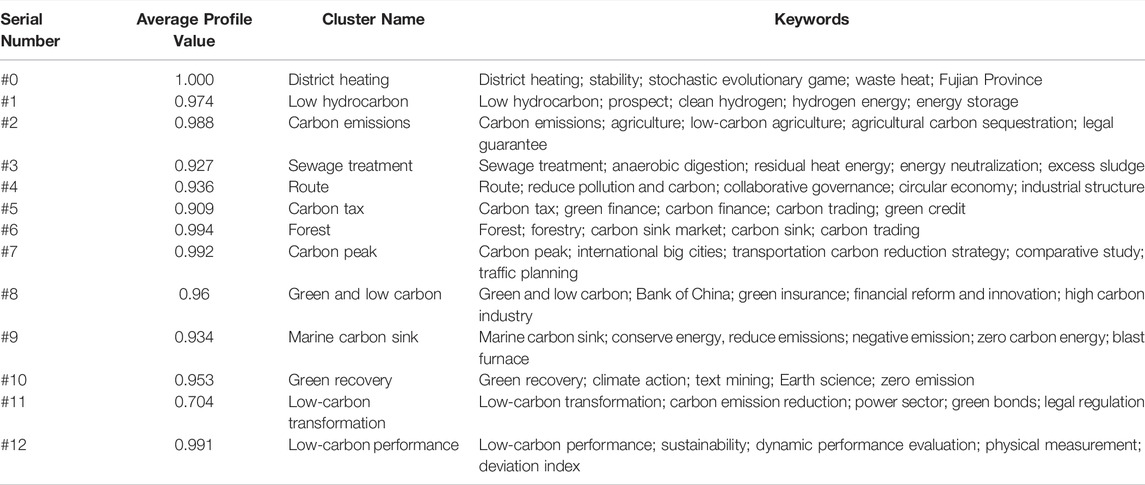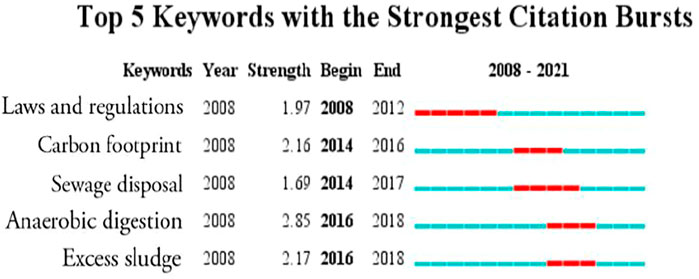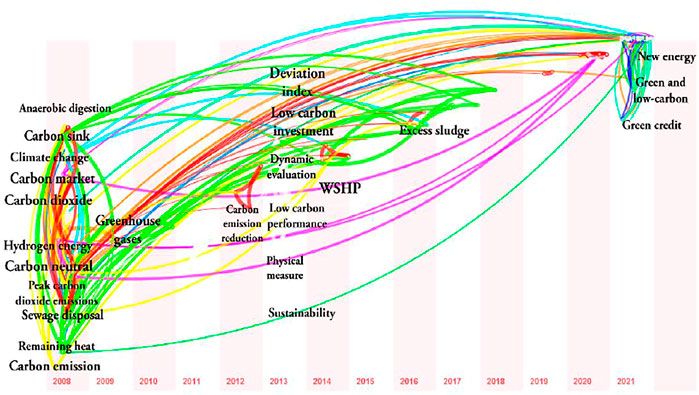- 1College of Economics and Management, Shenyang Agricultural University, Shenyang, China
- 2Accounting Finance & Strategic Investment Business School, Newcastle University, Newcastle Upon Tyne, United Kingdom
- 3Chinese Academy of Inspection and Quarantine, Beijing, China
In the context of global joint response to climate change, carbon neutralization has become one of the main measures for governments, enterprises, and even individuals around the world to deal with global warming. This article explores the current research status and frontier trends in the field of carbon neutralization, which can not only provide theoretical reference for the follow-up research of carbon neutralization but also provide useful ideas for the policy-making of carbon neutralization. The study is built on the China National Knowledge Infrastructure (CNKI) Core Journals Database, the Chinese Social Sciences Citation Index database, and the Chinese Science Citation Database as the literature retrieval database platform. Using CiteSpace optical measurement software, 370 pieces of literature in the field of carbon neutrality research in China were systematically analyzed to track the situation and impact of research by various research institutions and prominent authors in China in this field and to analyze the research hotspots in this field, which is of great significance for the follow-up research of carbon neutrality. The research results show that 1) the number of publications in China’s carbon-neutral field has increased significantly with the change of years and has strong development potential. 2) Journals with many articles are more concentrated and are generally published in three journals: Natural Gas Industry, Proceedings of the CSEE, and Chinese Science Bulletin. 3) In terms of the major research institutions, the Institute of National Conditions of Tsinghua University, the School of Public Administration of Tsinghua University, the School of Grammar of Beijing University of Technology, and the Economic Development Research Center of the State Forestry and Grassland Administration have published more articles and muscular scientific research strength in the field of carbon neutrality. 4) In terms of the principal authors, four typical research teams have been set up: low-carbon economy, low-carbon cycle, carbon trading, sewage carbon neutrality, environmental science, and resource utilization, and the authors of each research team cooperate closely. 5) In the future, the research hotspots in China’s carbon-neutral field are still the themes of carbon emission reduction, green and low carbon, new energy, etc., and the research hotspots have begun to shift to the concept of development, from the very beginning of environmental protection and carbon emission reduction to the current new energy development. Carbon neutrality is currently a hot research field in China, and in the future, special attention should be paid to the full use of machine learning and extensive data mining to solve complex social, economic, and ecological problems. It is suggested that China should introduce the concepts of “common but differentiated responsibilities” and “consumer responsibility” in the international climate change negotiations in the formulation of carbon neutralization policies, so as to fully protect the right to the development of China’s underdeveloped regions and avoid the injustice caused by the blind formulation of carbon neutralization policies.
Systematic Review Registration: [https://review.frontiersin.org/review/896524/16/1295417/#tab/History]
1 Introduction
With the continuous development of modern industrialization and the continuous improvement of living standards, human demand for energy has grown by 3% per year (Wang and Huang 2007; Ahmad et al., 2020; Ahmad et al., 2021a; Ahmad et al., 2021b). The combustion of fossil fuels such as coal and oil and the large number of gas emitted in the industrial production have led to a global greenhouse effect with an increasing scope of impact. As a result of the intensification of the worldwide greenhouse effect, humanity is experiencing a series of catastrophic climate changes such as floods, droughts, fire, and sea-level rise. The global average temperature is increasing at an unprecedented rate, and the change in carbon dioxide concentrations in the Earth’s atmosphere from 1960 to 2018 is shown in Figure 1.
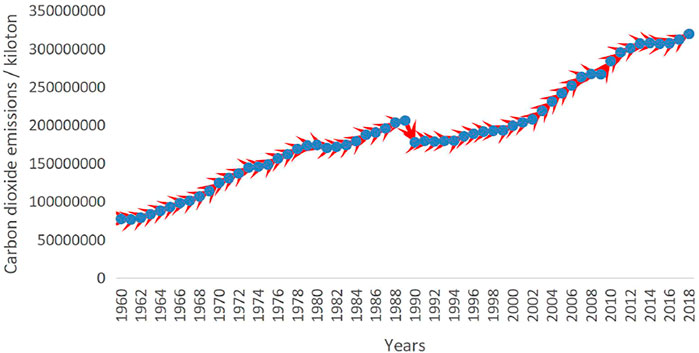
FIGURE 1. Carbon dioxide concentration in the Earth’s atmosphere (1960–2018). Data Source: The data source was obtained from the Carbon Dioxide Information Analysis Center, Department of Environmental Sciences, Oak Ridge National Laboratory, Tennessee 2022, https://data.worldbank.org.cn/indicator/en.atm.co2e.kt. Source Note: Carbon dioxide emissions are emissions from the combustion of fossil fuels and cement production. They include carbon dioxide produced when consuming solid, liquid, and gaseous fuels and burning natural gas.
From Figure 1, it can be found that the overall concentration of carbon dioxide in the Earth’s atmosphere has been an upward trend, predicting that the concentration of carbon dioxide will increase in the future, but the amplitude may decrease. The reason is that countries around the world are gradually recognizing the negative impact of the greenhouse effect and are beginning to change, such as the Intergovernmental Panel on Climate Change (IPCC) released the Global 1.5°C Warming Special Report in 2018, which states that to achieve the goal of controlling global warming temperature within 1.5°C, it is necessary to achieve net-zero carbon emissions, that is, carbon neutrality, on a worldwide scale by the middle of the 21st century. Since then, countries around the world have set their carbon-neutral carbon peak time points, and China also announced at the general debate of the 75th session of the United Nations General Assembly in September 2020 that it will increase its nationally determined contributions, strive to peak carbon dioxide emissions by 2030, and strive to achieve carbon neutrality by 2060. Carbon neutrality has gradually become a multidisciplinary research hotspot, and although China’s carbon neutrality research started late, it has also accumulated fruitful research results in recent years (Wu and Tian 2022; Wang 2022; Xu et al., 2021; Zhao and Li 2021; Ke et al., 2021; Pan et al., 2021; Chen et al., 2021; Dai, 2015; Hu, 2021). Systematically sorting out these research results plays a vital role in better grasping the development context and frontier dynamics of research in this field and is critical to improving the efficiency of scientific research in this field. Bibliometric analysis methods have been widely used in the quantitative study of a research field literature (Xie and Yu 2021; Wan 2021; Liu et al., 2021; Song and Chen 2021; Junjie, 2021; Party, 2012; Shi et al., 2020; Shi et al., 2021), while CiteSpace software is also an influential visual analysis tool in the current bibliometric analysis, effectively describing the overall dynamics of developments in a discipline or research field (Xia and Yang 2021; Luo et al., 2021; Bai and Wang 2021; Sun and Shang, 2009; Weng, 2021; Yuan and Bi, 2006; Zhu, 2011). At the same time, knowledge graphs can combine information visualization techniques with traditional bibliometric analysis to generate different types of knowledge graphs through data mining, information processing, scientific measurements, and graph drawing and present more intuitive information to researchers (Li 2019; Pei 2021; Wang et al.,.2021). Therefore, based on bibliometric analysis methods and literature visualization tools, the research uses the China national knowledge infrastructure (CNKI) database as the data source and uses the scientific tool CiteSpace software to present the research status, hotspots, and development trends in China’s carbon-neutral field in the form of knowledge graphs to provide a valuable reference for follow-up research in the carbon-neutral field.
This article uses the methods of keyword clustering, keyword emergence, and keyword periodic change of CiteSpace software to analyze and reveal the research hotspots, development ideas, and strategic considerations in the field of carbon neutralization in the future. The research results can not only improve the theories including Pigou tax, carbon tax, Coase theorem, carbon emission trading, and Nordhaus’s general equilibrium model with carbon constraints but also empirically promote the “China carbon neutralization model” to the world.
2 Materials and Methods
2.1 Data Sources
This article uses the core journals in the China National Knowledge Infrastructure (CNKI) database, the Chinese Social Sciences Citation Index (CSSCI) database, and the Chinese Science Citation Database (CSCD) as the literature retrieval database platform to ensure the authority and typicality of the research results. The scope of the literature selected and analyzed seems to be limited only to those written in Chinese or published in China. Missing research articles written by Chinese scholars but published on the platforms of international journals may have impact on the preciseness of the argument and the importance of the research results. However, research still has certain significance. The reasons are first, CNKI, CSSCI, and CSCD databases are important factors to measure whether Chinese scholars, research institutions, and projects are concluded or not. Second, research articles written by Chinese scholars but published on the international journal platform can be more or less see its “shadow” in domestic journals, which will not have a great impact on the overall research results and conclusions of this article. Specifically, “carbon neutralization” was used as the keyword for fuzzy retrieval. The data retrieval period was 2008–2021. Seven hundred and ninety-one articles were initially retrieved, and 370 articles were finally retained by manually interpreting the titles and abstracts of the documents, removing the irrelevant literature, conference reports, and news publicity. Retrieved literature records are exported in the Refworks format and saved as plain text files, and the data samples are analyzed in the text after being converted by the CiteSpace software. Considering the concentration and accuracy of the literature, the search strategy is set to TI=(“ecosystem services” or “environmental services” or “ecological services” or “ecosystem service” or “environmental service” or “environmental service” or “ecological service”) AND language: (English) AND Document Type: (Article). Choosing keywords rather than topics as search criteria avoids many irrelevant results. After the sample size is finalized, the target literature is exported and transcoded in the reference format required by CiteSpace to obtain the research sample database of this article.
2.2 Research Methods
2.2.1 Bibliometric Analysis Software
CiteSpace software is currently one of the most effective analytical tools in bibliometric analysis (Qiu et al., 2014; Qiu 2018), which is a Java application for literature analysis visualization developed by Chaomei Chen and a Chinese scholar at Drexel University in the United States (Lei 2017). The software can be obtained for free from the website (http://cluster.ischool.drexel.edu/-cchen/CiteSpace/download/). This article uses 5.8 R3c version and Excel to explore the research in China’s carbon-neutral field.
CiteSpace software’s collaborative network analysis (lead authors and research institutions), co-existent network analysis (keywords), and other statistical analysis functions can help scholars to objectively understand the current status of the target research field in terms of time, research institutions and members, keywords, etc. (Ji et al., 2019; Han et al., 2021). To meet the requirements of using these functions and to learn from existing research practices, the parameters of the CiteSpace software are set as follows.
2.2.2 Parameter Setting
1) Time slicing is 2008–2021, and the year of each slice (years per slice) = 1.2. Node types select the research institutions, authors, and keywords. 3) On the selection criteria, this article selects 50 entries from each slice where research institutions and keywords are cited the most or appear most frequently. For authors, 20 entries with the highest frequency are selected to ensure the authority and typicality of the authors obtained. 4) The settings on this article are trimmed, and “Pathfinder” is selected to eliminate some redundant connection. The other settings are still at default.
3 Results and Analysis
3.1 Analysis of Basic Characteristics of the Literature
The analysis of the basic characteristics of the literature mainly includes two aspects: the number of articles published and the main source journals. Among them, the change in the number of documents published is an important index to measure the research in a certain field (Schjønning et al., 1999; Xiao et al., 2017; Xu et al., 2015). The principal source journals can measure the relevant research in a certain field and prefer the authoritative journals published.
3.1.1 Number of Documents Issued
Changes in the volume of literature published are an essential indicator of research in a particular field (Schjønning et al., 1999; Xiao et al., 2017; Xu et al., 2015). From 2008 to 2021, the number of publications in China’s carbon-neutral field (Figure 2) continued to increase, showing that this field has received widespread attention from scholars and has strong development potential.
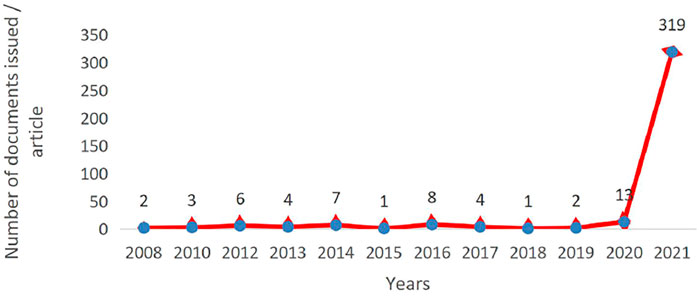
FIGURE 2. Statistics on the number of publications in China’s carbon neutral field from 2008 to 2021.
From Figure 2, it can be noted that the overall volume of articles published in the carbon-neutral field from 2008 to 2021 showed an upward trend, and the number of articles showed two breakthroughs. The first time was in 2020 when the number of articles published that year exceeded 10 for the first time. Previously, the number of articles published was prolonged, and after 2019, it began to grow steadily, and the research results gradually increased. The second time was in 2021 when the number of articles published exceeded 300 for the first time, and it is expected that the number of articles published will continue to increase after that.
3.1.2 Main Source Journals
In analyzing research in China’s carbon-neutral field, the top 10 journals with the highest number of articles are shown in Figure 3. It can be found that these journals have the characteristics of a wide range of research areas and a high concentration of articles.
From Figure 3, it can be found that in the journals in China’s carbon neutrality and related research fields, the top 10 journals with articles include oil and gas engineering, agroecology, applied ecology, and other disciplines, indicating that carbon-neutral research involves multiple disciplines and is highly interdisciplinary. Among the top 10 journals with the highest number of articles, the journal Natural Gas Industry accounted for the most significant proportion of 25.26% (24 articles), and the second-largest journal was Proceedings of the CSEE (10.53%, 10 articles) and Scientific Bulletin Chinese Science Bulletin (10.53%, 10 articles). Studies illustrating carbon neutrality are generally published in these three journals.
3.2 Analysis of Major Research Institutions and Authors
By analyzing the main research institutions and main authors, we can judge the main scientific research forces and the close cooperation between them in the field of carbon neutralization.
The visualization atlas created by CiteSpace consists of two parts: nodes and wiring, nodes representing major research institutions, significant authors, keywords, etc. The larger the node, the more articles of the affiliated research institutions and authors; the connection between the nodes indicates that there is cooperation between the research institutions and the authors, the thicker the link, the closer the association, and conversely, the lack of connection between the nodes means that there is no cooperative relationship between the institutions.
3.2.1 Major Research Institutions
Running the CiteSpace software, the period is set to 2008–2021, the time slice is 1 year, the node type is selected as the institution, the number of nodes obtained is 102, the number of connections is 70, and the density is 0.0136. Among them, the number of nodes relates to the number of research institutions in the graph. The connection between nodes represents that the research institutions have appeared in the same literature and there is a cooperative relationship between them. Network density refers to the “actual number of relationships” in the network that was separated by the “theoretical maximum number of relationships.” There is no unambiguous standard for this index. Collaborative network of the leading research institutions for carbon-neutral research load is shown in Figure 4.
From Figure 4, it can be found that the Institute of National Conditions of Tsinghua University, the School of Public Administration of Tsinghua University, the School of Grammar and Law of Beijing University of Technology, and the Economic Development Research Center of the State Forestry and Grassland Administration have large nodes, indicating that these research institutions have issued more articles in carbon-neutral research and have muscular scientific research strength. From the connection strength of node 4 in Figure 4, it can also be found that there is a robust cooperative relationship between two research institutions in the same department or the same city. Among the carbon-neutral research institutions, universities and research institutes are the mainstays, of which universities make up the most significant proportion.
3.2.2 Principal Author
The CiteSpace software is run, the node type of Author is set, and the other parameters that are the same as the research institution is set. The author collaboration network in Figure 5 consists of 110 authors and 79 pooled connections at a density of 0.0132, demonstrating that China’s carbon neutrality research has a large number of scholars and a wide range of collaboration. Collaborative Network of Authors of Carbon Neutral Studies is shown in Figure 5.
As can be seen from Figure 5, there are currently four important research team collaborators and research areas in China on carbon neutrality research, as follows:
1) The research team with Angang Hu as the core (red circle area) published the most articles, reaching 54 articles. The connection between Angang Hu and min Liu, and Zhichen Lü is quite close, and cooperation is extensive. Angang Hu’s research team mainly focuses on innovative green development (Hu 2012a), low-carbon development (Hu 2012b), low-carbon cycle (Lv and Hu 2021), and low-carbon economy (Hu 2008).
2) The research team with Lu Nan as the core (purple circle area) has published more articles, reaching 50 articles. Nan Lu has a closer relationship with Chuan He, Tianqi Liu, and Xiangmei Lü and has cooperated more time. Lu Nan’s research team mainly concentrates on the low-carbon economy (Lv et al., 2021) and carbon trading (Wang et al., 2022).
3) The research team with Yanming Wan as the core (green circle area) has published more articles, reaching 41 articles. Yanming Wan collaborated closely with Jian Liu and Wei Liu. Yanming Wan’s research team’s research direction is mainly environmental science and resource utilization (Hao et al., 2020a; Hao et al.2019; Hao et al.2018; Hao et al.2016) and industrial economy (Liu et al., 2022); more attention is paid to the development of low-carbon clean hydrogen energy in China under the “double carbon” goal, which is also a hot issue in the field of carbon neutrality.
4) The research team with Xiaodi Hao as the core (blue circle area) has published 36 articles. The research direction of Xiaodi Hao’s research team is mainly environmental science and resource utilization (Hao et al., 2021a; Hao et al.2021b; Hao et al.2021c; Hao et al.2020b) and sewage carbon neutrality (Hao et al., 2020a; Hao et al.2019; Hao et al.2018; Hao et al.2016). Xiaodi Hao has a close relationship with Jie Liu and Ji Li, especially in 2021, with the most cooperation, and the common concern is the study of energy neutrality and carbon neutrality of sewage treatment (Hao et al., 2021d; Li et al., 2021; Hao et al., 2021e). From 2008 to 2021, Xiaodi Hao’s research team issued articles every year, especially in the past 2 years, which shows that Xiaodi Hao’s research team will continue to study the field of sewage carbon neutrality in the future.
3.3 Research Hotspot Analysis
Keyword clustering is often used to excavate research topics in a specific research field within a specified period (Xu 2019), while keyword emergences often reflect changes in a sharp increase or decrease in interest in a particular area of research, and through the detection of emerging words, research hotspots in different periods can be revealed (Zhang et al., 2017).
3.3.1 Keyword Clustering
To better explore the topic of carbon neutrality research, this article uses the CiteSpace software for keyword clustering. Keyword cluster analysis is based on co-occurrence analysis, using the statistical method of clustering to simplify the co-occurrence network relationship to a relatively small number of clusters (Tai 2021). The CiteSpace software is run, the node type is set to keywords, and other parameters are set to the same as those of the research institution; based on the keyword knowledge network map, the LLR algorithm is selected to obtain the carbon-neutral research keyword cluster map (Figure 6).
As can be seen from Figure 6, the keywords of carbon neutrality research are clustered into 13 categories, namely, district heating, low-carbon hydrogen, carbon emissions, sewage treatment, paths, carbon taxes, forests, carbon peaks, green low carbon, marine carbon sinks, green recovery, low-carbon transition, and low-carbon performance; the order is from 0 to 12, the smaller the number, the more keywords contained in the cluster; each cluster is composed of multiple closely related words, which keywords in the “Cluster Explorer” get the log-likelihood rate (one of the clustering label word extraction algorithms) to obtain a keyword co-occurrence network clustering table (Table 1). The newly formed cluster names actually exist in the network. However, CiteSpace software clusters the keywords that particularly closely relate through algorithms. Each keyword is subsequently given a value. The largest in the same cluster is chosen as the representative of the category and labeled, that is, the name of the newly formed cluster. In this network, it is necessary to pay attention to the average profile value of clustering, which characterizes the quality of clustering results, and it is generally believed that the average contour value of clustering is more significant than 0.5, and the clustering is reasonable; the average clustering value is more important than 0.7, and the clustering is convincing.
From Table 1, it can be found that the average contour values of the first 13 clusters in the carbon neutrality study are more significant than 0.7, indicating that the clustering results presented are convincing, which also confirms the correctness of the survey to choose carbon neutrality as the title of the article, such as #0 clustering: the research topics of district heating mainly include district heating, stability, stochastic evolutionary game, waste heat, and other keywords. It can be seen that they relate to the theme of energy. Similarly, topics under other clustering labels are also roughly the same.
From Table 1, it can also be found that there is a cross-cutting phenomenon in the research themes under each cluster, and the relevant research on carbon neutrality in China can be roughly summarized into three areas: “carbon emissions,” “carbon peaking,” and “green and low carbon”:
1) Carbon emissions. The field of carbon emissions includes keywords such as carbon emission, agriculture, low-carbon agriculture, agricultural carbon sink, and legal guarantee. In global warming, the energy transition has become a constant focus for governments. As China’s agricultural sector, second only to the energy sector in terms of greenhouse gas emissions, it has attracted great attention from the Chinese government. Depending on the current situation of carbon emission, China has further clarified and formulated the safeguard policies on agricultural carbon neutralization. The research on agriculture, low-carbon agriculture, and agricultural carbon sink will help China achieve carbon neutralization in agriculture and then promote carbon neutralization in other fields. In general, in any historical period, existing production and consumption patterns are the best thing matches between technology and economy under current conditions, with the rationality of existence (Yang 2010). It is of great significance for China’s agricultural development to analyze China’s existing agricultural production structure and agricultural consumption structure and explore the realization path of carbon neutralization by 2060.
2) Carbon peaks. The carbon peaking field includes keywords such as carbon peak, international big cities, transportation carbon reduction strategies, comparative research, transportation planning, and so on. By the end of 2020, China’s total highway mileage had reached 5,198,100 km, with 11.7154 million road operating vehicles, 612,600 passenger vehicles, 18.4089 million passenger seats, and 11.1028 million cargo vehicles. The huge transportation system has grown up to be an important carbon source of the city. Traffic carbon reduction is of great importance for the environmental beautification of cities and even countries. Built on carbon peaking and carbon neutralization, urban low-carbon transportation should focus on technical emission reduction and structural emission reduction.
3) Green and low carbon. The green and low-carbon field includes keywords such as green low carbon, bank of China, green insurance, financial reform and innovation, high carbon industry, and so on. At present, in the context of carbon neutrality, the accurate accounting of carbon emissions is not only a clear picture of China’s family background, providing a basis for international negotiations and the formulation of carbon-saving and emission reduction policies, but also an essential basis for entities at different levels to implement emission reduction tasks and assess the completion effect (Lulu 2021). Therefore, the development of carbon trading, building a perfect carbon emission accounting system, green insurance, and financial reform and innovation are important means to control carbon dioxide emissions (Liang 2017; Zhang et al., 2016; Liu 2013; Yao and Chen 2011). However, at present, the carbon emission accounting basis for products or services in most Chinese enterprises is still weak. It is recommended to conduct green certification for green and low-carbon products or projects in high-carbon industries on the basis of product or project carbon footprint accounting. Or use carbon tax, financial incentives, and other regulatory means to encourage enterprises to increase carbon emission accounting and management at the level of products or services.
3.3.2 Keyword Emergence
CiteSpace provides the function of burst detection, mainly to detect situations where there is a significant change in the number of references in a certain period (Wang, 2021; Hu and Feng 2021). Emergent detection is considered an indicator of highly active research fields, which can explore emerging trends and fleeting trends and provide a precise visual analysis of the duration of research hotspots in the domestic and foreign academic circles. The higher the intensity of keyword prominence, the more pronounced the research orientation, which is the node that needs to be given attention to in research. The study used CiteSpace’s sudden feature to map the intensity of a total of 5 keywords from 2008 to 2021, as shown in Figure 7. Among them, strength indicates the power of the sudden, begin indicates the year of the sudden start, end indicates the year of the premature termination, and the red part is the year of the keyword prominence.
It can be found from Figure 7 that first, from 2008 to 2021, the keyword with the highest burst intensity is “anaerobic digestion,” the strength value reaches 2.85, the starting sudden time was in 2016, and the end suddenness time was in 2018. Secondly, the keywords of “legal regulation,” “carbon footprint,” “sewage treatment,” and “residual sludge” once attracted much attention, and the sudden intensity was more significant than 1.65. Still, with the continuous refinement and maturity of carbon-neutral research, in addition to the keywords of “anaerobic digestion” and “residual sludge,” the attention of the remaining keywords has declined, and the research on carbon reduction technology is more than the jurisprudence research of humanities and social sciences.
3.3.3 Keyword Periodic Change Analysis
Keyword timing chart can be used to reflect the main research content of a research topic with time and can also skip the research trend in a certain period to a certain extent, so the CiteSpace software is run to generate keyword timing maps by time segments based on keyword co-occurrence analysis (Figure 8).
As shown in Figure 8, scholars pay attention to different keywords at different times. The evolution of carbon neutrality and correlation research in China can consist of three stages: the primary stage, the prosperity stage, and the new period stage:
1) Basic stage (2008–2012). In addition to carbon neutrality, carbon peaking, carbon markets, wastewater treatment, anaerobic digestion, and carbon emissions. At this stage, China’s carbon neutrality-related research is in the initial development period; Chinese scholars have a more tangible feeling and feeling about “global warming,” began to explore the causes of “global warming,” and realized that “carbon neutrality” should become a healthy concept and way of life for human beings (Wang et al., 2019; Fang et al., 2018; Ge et al., 2014).
2) Boom phase (2013–2019). China’s carbon neutrality and correlation research are more numerous at this stage. The study makes clear; more attention is paid to carbon measurement problems such as physical measurement, deviation index, dynamic assessment, and other keywords, and more concentration is paid to sustainable development research. And at this stage, there have been breakthroughs in the research direction, with the continuous maturity of carbon offsetting mechanisms, methodologies and carbon markets, and carbon neutrality as an effective environmental management tool (Zhang et al., 2022; Zhao and Li 2021; Ke et al., 2021; Lou 2021; Deng et al., 2013), gradually gaining more and more support from governments, businesses, and people; the trend of voluntary global carbon reduction actions has changed accordingly, and it has transitioned from organizing carbon footprint inventory to carbon neutrality (Cheng 2021).
3) New era stage (2020–2021). In September 2020, Chinese President Jinping Xi proposed the general debate of the 75th session of the United Nations General Assembly that “carbon emissions should peak by 2030 and strive to achieve carbon neutrality by 2060.” At the Leaders’ Climate Summit in April 2021, President Xi proposed that jointly building a community of human and natural life, as the largest carbon emitter, means that China has to be done more in carbon reduction and carbon treatment. Therefore, keywords at this stage are more “new energy,” “green credit,” and “green and low carbon.”
4 Discussions
Based on the essential characteristics of the literature in carbon neutrality in China, the analysis of major research institutions, prominent authors, and research hotspots, the research progress of carbon neutrality and the direction of future carbon-neutral research are discussed. First, the study only counted and analyzed the number of publications in the field of carbon neutrality, but the number of citations was not counted and analyzed, which is one of the drawbacks of CiteSpace software, follow-up will continue to explore the global carbon neutrality problem; secondly, the future of China’s carbon-neutral field research hotspots is still carbon emission reduction, low green carbon, new energy, and other topics, and China’s research hotspots have also begun to tend to the development concept of the change, from the very beginning of environmental protection, carbon emission reduction, to the current new energy development. The growing recognition that carbon neutrality is a strategic consideration also means strategic opportunity. In short, under the premise of ensuring national energy security, if China wants to achieve the goal of “carbon peaking and carbon neutrality,” it needs to combine energy structure adjustment, technological innovation, and green engineering, improve the efficiency of fossil energy use, reduce carbon emissions, vigorously develop new energy, and help adjust the energy structure. “Carbon neutrality” is a profound change that requires the joint efforts of society and even all humanity.
Previous discussions and studies on carbon neutralization in China have mainly formed three views. First, optimists. It is estimated that carbon neutralization requires more investment in supporting infrastructure, and the conversion of traditional fossil energy into new energy requires a lot of investment, which can promote the rapid growth of China’s economy again. The optimistic view is usually valid, but it fails to really reveal the internal mechanism of how carbon neutralization promotes economic growth. Second, pessimists. Pessimists and optimists hold the opposite view. They believe that China’s traditional fossil energy accounts for 85% of the total energy. It is difficult to find alternative green energy in a period of time, and carbon neutralization puts too much pressure on China. However, this article holds that the proposal of China’s carbon neutralization goal is how to build a prosperous new world under the assumption that the global fossil energy will be exhausted by 2060? If you look at carbon neutralization in this way, you will not be particularly pessimistic. Third, the green school. It is considered that without changing the traditional industrialization mode, the problems of energy and environment can be solved by using technological progress, such as new technologies and new materials, including carbon capture technology, environmental protection technology, energy conservation and emission reduction technology, etc. This article acknowledges that technological progress is important for carbon neutralization, but new problems will continue to arise because new technologies can only solve old problems. The most typical is the “Jevons paradox” in the energy industry. People think that after the application of the steam engine, the significant improvement of energy efficiency will lead to the decline of coal consumption, but in fact, coal consumption is increasing. Therefore, this article believes that technology is of great importance, but the problem of carbon neutralization cannot be simply attributed to technological innovation. Only by changing the concept of comprehensive development, innovating the organizational model, and innovating the system and mechanism can we better address the issue of carbon neutralization.
The scope of the literature selected and analyzed is apparently limited only to those written in Chinese or published in China. This will lead to the lack of research articles written by Chinese scholars, but published on the platforms international journals, which may have a negative impact on the preciseness of the argument and the importance of the research results. In the next step, the SCI-E and SSCI databases of the “web of science core collection” will be used as the sample data source, and the CiteSpace visual measurement software will be used to systematically analyze the international carbon neutralization research, so as to improve and deepen the research on carbon neutralization in China.
Although the CiteSpace software used in this article has been widely used in bibliometric research, there are still some problems such as the inability to distinguish between the first author and the corresponding author of the document and the failure to conduct citation analysis for the Chinese literature study. The use of machine learning to achieve carbon-neutral interdisciplinary modeling will provide indispensable ideas for systematically solving complex socio-economic problems. Therefore, in the future, methods such as machine learning and extensive data mining will be considered to be incorporated into research in the carbon-neutral field. Of course, the study was based on a bibliometric analysis of objective bibliographic data, and the results were stable and reliable and generally unaffected by empiricism. Therefore, the research conclusions of this article have a definite theoretical value and reference significance for the research status and frontier grasp of carbon-neutral fields.
5 Conclusion
The research took the core journals of “China National Knowledge Infrastructure (CNKI),” the “Chinese Social Sciences Citation Index (CSSCI),” and “Chinese Science Citation Database (CSCD)” as sample data sources based on bibliometric analysis methods. With the help of CiteSpace visualization software, the knowledge map of China’s carbon neutrality research from 2008 to 2021 was drawn, and the essential characteristics of the literature in this research field, the leading research institutions and authors, and the research hotspots were systematically and informatively analyzed. The next research will take the SCI-E and SSCI databases of “web of science core collection” as the sample data source and continue to use CiteSpace visual measurement software to systematically analyze the international carbon neutralization research, so as to improve and deepen the research on carbon neutralization in China. The findings of this study:
1) Basic characteristics of the literature. In terms of the amount of text posted. The number of articles published in China’s carbon-neutral field has shown an upward trend year by year, especially in the past 2 years, after China proposed “carbon peaking and carbon neutrality”; the discussion of carbon neutrality topics has attracted much attention, which fully shows that this field has received extensive attention from scholars and has strong development potential, in terms of significant source journals. Research associated with the carbon-neutral area is generally published in three journals: Natural Gas Industry, Proceedings of the CSEE, and Chinese Science Bulletin.
2) Major research institutions and authors. In terms of major research institutions, the Institute of National Conditions of Tsinghua University, the School of Public Administration of Tsinghua University, the School of Grammar of Beijing University of Technology, and the Economic Development Research Center of the State Forestry and Grassland Administration have published more articles and have more muscular scientific research strength in the carbon-neutral field; the cooperative relationship between two research institutions in the same department or the same city is more substantial from the connection strength, and among the carbon-neutral research institutions, universities and research institutes are the mainstays, of which universities account for the most significant proportion. In terms of the principal authors, four typical research teams have been set up; the research directions are low-carbon economy, low-carbon cycle, carbon trading, sewage carbon neutrality, environmental science, and resource utilization, and the authors of each research team cooperate closely.
3) Research hotspots. In terms of keyword clustering, the average profile values of the 13 keywords related to the carbon neutrality study were all greater than 0.7, and the clustering results were convincing, which confirmed the correctness of the survey to choose carbon neutrality as the title of the article. In addition, there is a phenomenon of intersectionality in the content of research topics under various clusters, and carbon neutrality and related research are roughly summarized into three areas: “carbon emissions,” “carbon peaking,” and “green and low carbon”: first, the field of carbon emissions. In global warming, the energy transition has grown up to be a constant focus for governments. Countries have drawn up and adopted energy transition plans and increased investment in low-carbon energy. China pays more attention to agricultural carbon emission reduction. The second is the area of carbon peaking. China has a huge transportation system. It is of great significance to beautify China’s transportation environment. The third is the green and low-carbon field. It is recommend that Chinese enterprises carry out green certification for green and low-carbon products or projects in high-carbon industries on the basis of product or project carbon footprint accounting, in terms of keyword emergence. During the period 2008–2021, the keyword with the highest intensity of emergence was “anaerobic digestion.” With the continuous refinement and maturity of carbon-neutral research, the keywords of “anaerobic digestion” and “residual sludge” are still attracting attention. Research on the carbon reduction technology is more than the jurisprudence research of humanity social sciences in terms of keyword periodic changes. The evolution of carbon neutrality research in China has been distributed into three stages: the primary stage, the prosperity stage, and the new period stage. The first is the preliminary stage (2008–2012). At this stage, China’s carbon neutrality research is in its infancy, and Chinese scholars have started to explore the causes of “global warming.” The second is the boom phase (2013–2019). China has more carbon neutrality and correlation research, more specific research, more attention to carbon measurement issues, and sustainable development research. The third is the modern era stage (2020–2021). China has successively proposed “carbon peaking, carbon neutrality” and “jointly building a community of human and natural life,” which means that China has to be done more in carbon emission reduction and carbon treatment.
Data Availability Statement
The original contributions presented in the study are included in the article/Supplementary Material, further inquiries can be directed to the corresponding author.
Author Contributions
Conceptualization, XS and JZ; methodology, XS; formal analysis, XS, JZ, and TW; data curation, XS and JZ; writing—original draft preparation, XS and JZ; writing—review and editing, XS, SL, and XZ; and supervision, XS. All authors have read and agreed to the published version of the manuscript.
Funding
This research was funded by the Social Science Planning Fund Project of Liaoning Province [grant number L17CGL008]; in part by the Scientific Research Funding Project of the Education Department of Liaoning Province, “Research on Construction of Evaluation Index for Sustainable Development of Wetland Resources Ecological Economy in Liaoning Province” [grant number WSNJC202035]; in part by the Fund for Postdoctoral Research of Shenyang Agricultural University [grant number 770218007]; in part by the introductory Talent Research Start Project of Shenyang Agricultural University [grant number 2016]; and in part by the Key Research and Development projects of the Hebei Province Study on the browning control method in the thermal processing of flexible pouch chestnut [grant number 20327113D].
Conflict of Interest
The authors declare that the research was conducted in the absence of any commercial or financial relationships that could be construed as a potential conflict of interest.
Publisher’s Note
All claims expressed in this article are solely those of the authors and do not necessarily represent those of their affiliated organizations, or those of the publisher, the editors, and the reviewers. Any product that may be evaluated in this article, or claim that may be made by its manufacturer, is not guaranteed or endorsed by the publisher.
References
Ahmad, M., Rehman, A., Shah, S. A. A., Solangi, Y. A., Chandio, A. A., and Jabeen, G. (2020). Stylized Heterogeneous Dynamic Links Among Healthcare Expenditures, Land Urbanization, and CO2 Emissions across Economic Development Levels. Sci. Total Environ. 753 (1), 142228–142312. doi:10.1016/j.scitotenv.2020.142228
Ahmad, M., Jabeen, G., Irfan, M., Işık, C., and Rehman, A. (2021a). Do inward Foreign Direct Investment and Economic Development Improve Local Environmental Quality: Aggregation Bias Puzzle. Environ. Sci. Pollut. Res. 28, 34676–34696. doi:10.1007/s11356-021-12734-y
Ahmad, M., Khan, Z., Anser, M. K., and Jabeen, G. (2021b). Do rural-urban Migration and Industrial Agglomeration Mitigate the Environmental Degradation across china's Regional Development Levels? Sustainable Prod. Consumption 27, 679–697. doi:10.1016/j.spc.2021.01.038
Bai, X., and Wang, J. (2021). A Review of Neuroscientific Methods in Foreign Library and Information Science Based on Emotional Space. Inf. Sci. 39 (3), 185–192.
Chen, F., Yu, H., Bian, Z., and Yin, D. (2021). Crisis and Response of Coal Industry Development under the Vision of Carbon Neutrality. J. coa 46 (6), 1808–1820.
Cheng, H. (2021). Analysis on the Development Crisis of Coal Industry under the Vision of Carbon Neutrality. Inner Mongolia coal economy 1 (15), 1–3.
Dai, X. (2015). Analysis on Influencing Factors of Coal Carbon Emission and Research on Emission Reduction Measures in China. Beijing: China University of mining and technology.
Deng, M., Luo, W., and Yin, L. (2013). Review on Theoretical Research and Practical Development of Carbon Neutralization Abroad. Resource Sci. 35 (5), 1084–1094.
Fang, J., Zhu, J., and Shi, Y. (2018). The Responses of Ecosystems to Global Warming. Chin. Sci. Bull. 63 (2), 136–140. doi:10.1360/n972017-00916
Ge, Q., Wang, F., Wang, S., and Cheng, B. (2014). Determination and Uncertainty of Seven Problems in Understanding Global Warming. China Popul. Resour. Environ. 24 (1), 1–6.
Han, C., Wang, J., and Wang, G. (2021). Bibliometric Analysis of Chinese Grass and Animal Husbandry Research Based on CiteSpace. Grass Industry Sci. 38 (5), 976–991.
Hao, X., Fang, X., Li, J., and Jiang, H. (2018). Analysis of Carbon Neutralization Potential of Sewage. China water supply and drainage 34 (10), 11–16.
Hao, X., Li, J., and Cao, D. (2016). Sludge Increment Is Required for Carbon Neutralization Operation of Sewage Treatment. China water supply and drainage 32 (12), 1–6.
Hao, X., Rao, Z., Li, S., Li, J., and Jiang, H. (2021c). Sewage Residual Heat Energy Contains Potential Carbon Trading Volume. China water supply and drainage 37 (12), 7–13.
Hao, X., Rao, Z., Liu, r., and Liu, J. (2021d). Effect and Mechanism Analysis of Cellulose on the Performance of Sewage Biological Treatment System. China water supply and drainage 37 (21), 1–6.
Hao, X., Wang, B., Liu, r., and Jiang, H. (2021b). Carbon Neutralization vs Excess Methane Release from Water/Methane Paradox. J. Environ. Sci. 41 (5), 1593–1598.
Hao, X., Wang, X., Jiang, H., and Li, S. (2019). Comprehensive Environmental Benefit Evaluation Method and Case Application of Sewage Treatment. China water supply and drainage 35 (6), 6–15.
Hao, X., ye, J., Liu, r., and Li, J. (2020b). Production and Influence of Soluble Microbial Metabolites in Effluent of Sewage Plant. China water supply and drainage 36 (12), 37–44.
Hao, X., Yu, J., Liu, r., Liang, Y., and Li, F. (2020a). Recovery of Ash and Phosphorus from Excess Sludge Incineration and its Technical Progress. J. Environ. Sci. 40 (4), 1149–1159.
Hao, X., Zhang, Y., Li, J., and Liu, J. (2021e). Case Study of Energy Neutralization and Carbon Neutralization in Sewage Treatment. China water supply and drainage 37 (20), 1–8.
Hao, X., Zhao, Z., Li, J., Li, S., and Jiang, H. (2021a). Energy and Resource Recovery Methods and Carbon Emission Accounting of Sewage Treatment Plants: a Case Study of Kakolanm, Finland? Ki Sewage Treatment Plant as an Example. J. Environ. Eng. 15 (9), 2849–2857.
Hu, A. (2008). New connotation of the “Green Cat” model - low carbon economy. World Environment 1 (2), 26–29.
Hu, M., and Feng, D. (2021). Research Hotspot and Development Trend of Land Use Transformation in China -- Econometric Analysis Based on CiteSpace. Nanfang Agric. machinery 52 (10), 17–19.
Ji, Q., Huang, W., Min, Y., and Fu, G. (2019). Research Hotspots and Trends of Ecological Livability Based on Bibliometrics. J. Ecol. 39 (9), 3392–3399. doi:10.5846/stxb201809292124
Junjie, L. (2021). Information Disclosure, Incentive and Restraint and Tourism Carbon Emission Regulation -- Game Analysis Based on Bayesian Law. J. Cent. South Univ. For. Tech. 41 (5), 174–181.
Ke, N., Lu, X., Kuang, B., and Han, J. (2021). Regional Differences and Influencing Factors of green and Low-Carbon Utilization of Cultivated Land in China under the Goal of Carbon Neutralization. China land Sci. 35 (8), 67–76.
Lei, X. (2017). Research on Adult Learning Psychology under the Background of Learning society:Retrospect and prospect. Hangzhou: Zhejiang University of Technology.
Li, T., Wu, Y., Hao, X., Wang, B., Xu, L., Liu, J., et al. (2021). Error Source Analysis and Impact Assessment of Water Quality Data in Sewage Biological Treatment Modeling. J. Environ. Sci. 41 (11), 4576–4584.
Li, X. (2019). Research Status and Hotspot Mining of Metrology Scientific Research in My Country Based on Knowledge Graph. Metrology Test. Tech. 46 (11), 95–98.
Liang, y. (2017). Research on the Establishment of China's Carbon Emission Trading System Based on Total Amount Control. Harbin: Northeast Forestry University.
Liu, C. (2013). Research on the Construction of Carbon Emission Trading Mechanism in Hubei Province. Wuhan: Hubei University.
Liu, W., Wan, Y., Xiong, Y., and Liu, J. (2022). Progress and Prospect of Low Carbon Clean Hydrogen Energy in China under the Goal of "double Carbon. Energ. storage Sci. Technol. 11 (2), 635–642.
Liu, Y., Shi, D., Liu, J., Tang, L., and Wang, J. (2021). Research Status and Hot Spot Analysis in the Field of Artificial Intelligence Based on Bibliometrics. Res. Sci. Technol. Manag. 41 (10), 38–48.
Lulu (2021). Thoughts on Improving China's Carbon Emission Accounting System under the Background of Carbon Neutralization. Southwest finance 2 (12), 15–27.
Luo, K., Zhang, Y., and Li, Z. (2021). An Investigation of the Changes in the Academic Field of Public Health Incident Research in China: Visual Analysis Based on CiteSpace Knowledge Graph (2000-2019). Journalism Bimonthly 1 (5), 22–39.
Luo, P. (2021). Research on Carbon Auditing Under “Double Carbon” Target: The Case of Company A. Investment and Entrepreneurship 32 (24), 210–213.
Lv, X., Liu, T., Liu, X., He, C., Nan, L., and Zeng, H. (2021). Recent Low-Carbon Economic Dispatch of Multi Energy parks Considering High Proportion of New Energy Consumption. J. Shanghai Jiaotong Univ. 55 (12), 1586–1597.
Lv, Z., and Hu, A. (2021). Building a Modern Economic System of green and Low-Carbon Circular Development in China: Realization Path and Practical Significance. J. Beijing Univ. Tech. (SOCIAL SCIENCES EDITION) 21 (6), 35–43.
Pan, J., Liao, M., and Chen, S. (2021). Carbon Neutrality: How Fast Can China Go?. Reform 2 (7), 1–13.
Party (2012). Government and Army Role and Impact Mechanism of Clean Coal Utilization on China's Energy Security. Beijing: China University of Geosciences.
Pei, M. (2021). Information Visualization Analysis of "Human Resource Development in China" Based on Bibliometrics. China Business Rev. 1 (6), 168–170.
Qiu, Ju. (2018). Analysis and Application of Knowledge Visualization Based on CiteSpace-A Case Study of International Attendance Behavior. Inf. Sci. 36 (12), 139–144.
Qiu, S., Pan, L., and Hou, J. (2014). Hotspots and Frontier Evolution of International Preschool Education Research in the 21st Century:Quantitative and Visual Analysis Based on the Five Most Influential Preschool Education Periodicals in SSCI. Preschool Edu. Res. 1 (6), 10–20.
Schjønning, P., Thomsen, I. K., Møberg, J. P., de Jonge, H., Kristensen, K., and Christensen, B. T. (1999). Turnover of Organic Matter in Differently Textured Soils :I. Physical Characteristics of Structurally Disturbed and Intact Soils. Geoderma 89 (3), 177–198.
Shi, X., Chen, K., Lu, C., Chen, L., He, D., Cao, X., et al. (2020). Comprehensive Evaluation of forest Ecosystem Service Value in Case of Jilin forest Industry Group. Fresenius Environ. Bull. 29 (5), 3491–3504.
Shi, X., Wang, T., Chen, K., Cao, X., He, D., Xu, Z., et al. (2021). Reliability Analysis and Cumulative Impact Assessment of Forest Ecosystem Services: A Case Study of Jilin Province, China. IEEE Access 99, 1–14. doi:10.1109/access.2021.3071123
Song, W., and Chen, S. (2021). Analysis on Research Progress of Agricultural Insurance Based on Bibliometrics. Lanzhou J. 1 (5), 102–115.
Sun, Y., and Shang, Y. (2009). Complementarity between green Coal Mining and Comprehensive Desert Management. J. coal 34 (12), 1643–1648.
Tai, Z. (2021). Research on CO Word Clustering Based on Community Detection Algorithm. Taiyuan: Shanxi University.
Wan, Y. (2021). Open a Sail Analysis on the Research 2status of National Governance Based on Bibliometrics. Scientific Res. Manag. 42 (8), 192–200.
Wang, D., Yang, H., Tian, Z., Sun, X., Zhou, Z., Zhu, Q., et al. (2021). Scientific Knowledge Map and Visualization Analysis in the Field of Objectification of Tongue Characteristics of Traditional Chinese Medicine. World Sci. Technology-Modernization Traditional Chin. Med. 23 (9), 3032–3040.
Wang, N., Yao, T., Xu, B., Chen, A., and Wang, W. (2019). Temporal and Spatial Pattern, Trend and Impact of Glacier Change in the Qinghai Tibet Plateau and its Surrounding Areas under the Background of Global Warming. J. Chin. Acad. Sci. 34 (11), 1220–1232.
Wang, S., Liu, T., He, C., Nan, L., and Lv, X. (2022). Comprehensive Energy Economic Dispatch of Park Based on comfort Demand Response and Carbon Trading. Electr. Meas. instrument 1 (2), 1–9.
Wang, Y., and Huang, N. (2007). Building Energy Conservation and Popularization and Application of Solar Energy. Shanghai construction Technol. 1 (2), 45–46.
Wang, Z. (2021). Current status and Trends of Russian Psycholinguistics Research in China—a CiteSpace-Based Knowledge Mapping Analysis. Journal of Hebei North College (Social Science Edition) 37 (6), 51–57.
Wang, Z. (2022). Review on Carbon Trading Efficiency and enterprise Emission Reduction Decision. J. Beijing Univ. Tech. (SOCIAL SCIENCE EDITION) 24 (1), 187–188.
Weng, B. (2021). Library Security Exploration Based on CiteSpace Analysis. J. Beijing Inst. printing 29 (11), 172–174.
Wu, L., and Tian, Q. (2022). Study on Carbon Ecological Security and Ecological Compensation in China under the Goal of Carbon Neutralization. Geographical Res. 41 (1), 149–166.
Xia, R., and Yang, J. (2021). Analysis and Prospect of Interdisciplinary Research on Linguistic Distance Based on CiteSpace. Foreign Language World 1 (2), 90–96.
Xiao, H., Wu, J., and Sun, J. (2017). Significance and Role of Academic Journal Dose-Response index (JMI). J. Editing 29 (4), 340–344.
Xie, X., and Yu, J. (2021). Analysis of Foreign Research Hotspots and Evolution Context of User Participation in Product Innovation -- from the Perspective of Bibliometrics. Management Rev. Nankai 24 (5), 4–17.
Xu, H., Yin, C., Guo, T., Tan, X., and Fang, S. (2015). Review of Interdisciplinary Research. Libr. Inf. Serv. 59 (5), 119–127.
Xu, Y. (2019). Research on Literature Clustering and Subject Change Analysis Method Based on Citation Network. Hangzhou: Zhejiang University of Finance and economics.
Xu, Z., Zuo, S., and Ding, S. (2021). Carbon Peaking and Carbon Neutralization Enable High-Quality Development: Internal Logic and Realization Path. Economist 11, 62–71.
Yang, C. (2010). Economic Analysis of Insufficient Consumption Demand in China. Chengdu: Sichuan Normal University.
Yao, X., and Chen, J. (2011). Enlightenment and Reference of the Development of European and American Carbon Emission Trading Market to China. Exploration Econ. Issues 1 (4), 35–38.
Yuan, Z., and Bi, J. (2006). Latest Research Progress and Trend prospect of Industrial Ecology. J. Ecol. 1 (8), 2709–2715.
Zhang, J., Wang, Z., Tang, L., and Yu, L. (2016). Research on the Impact of Beijing Tianjin Hebei Carbon Emission Trading Policy Based on System Dynamics. China Manag. Sci. 24 (3), 1–8.
Zhang, Y., Wu, C., Gao, H., Wang, X., Yao, r., Hu, W., et al. (2022). Eco Stoichiometric Characteristics of Carbon, Nitrogen and Phosphorus in Leaves and Soil of Torreya grandis Young forest. J. Cent. South Univ. For. Tech. 1 (1), 104–110.
Zhang, Z., Wang, X., and Wang, H. (2017). Comparative Study of Title and Keyword in Literature Content Disclosure -- Based on the Field of Agricultural Product Brand Evaluation. Inf. Sci. 35 (10), 88–93.
Zhao, Z., and Li, F. (2021). Theoretical and Practical Research on the Economics of Carbon Neutralization Technology. China soft Sci. 1 (9), 1–13.
Keywords: carbon neutralization, carbon peak, carbon emission, research frontier, citespace, China national knowledge infrastructure, China
Citation: Shi X, Zhang J, Lu S, Wang T and Zhang X (2022) China Carbon Neutralization Research Status and Research Frontier Tracking. Front. Environ. Sci. 10:896524. doi: 10.3389/fenvs.2022.896524
Received: 16 March 2022; Accepted: 11 April 2022;
Published: 26 May 2022.
Edited by:
Antonis A. Zorpas, Open University of Cyprus, CyprusReviewed by:
Munir Ahmad, Zhejiang University, ChinaKe Xing, University of South Australia, Australia
Dervis Kirikkaleli, European University of Lefka, Turkey
Copyright © 2022 Shi, Zhang, Lu, Wang and Zhang. This is an open-access article distributed under the terms of the Creative Commons Attribution License (CC BY). The use, distribution or reproduction in other forums is permitted, provided the original author(s) and the copyright owner(s) are credited and that the original publication in this journal is cited, in accordance with accepted academic practice. No use, distribution or reproduction is permitted which does not comply with these terms.
*Correspondence: Xiaoliang Shi, c3hsNDIyMTI3QHN5YXUuZWR1LmNu
 Xiaoliang Shi
Xiaoliang Shi Jiayi Zhang
Jiayi Zhang Shuaiyu Lu
Shuaiyu Lu Tielong Wang
Tielong Wang Xinyue Zhang
Xinyue Zhang